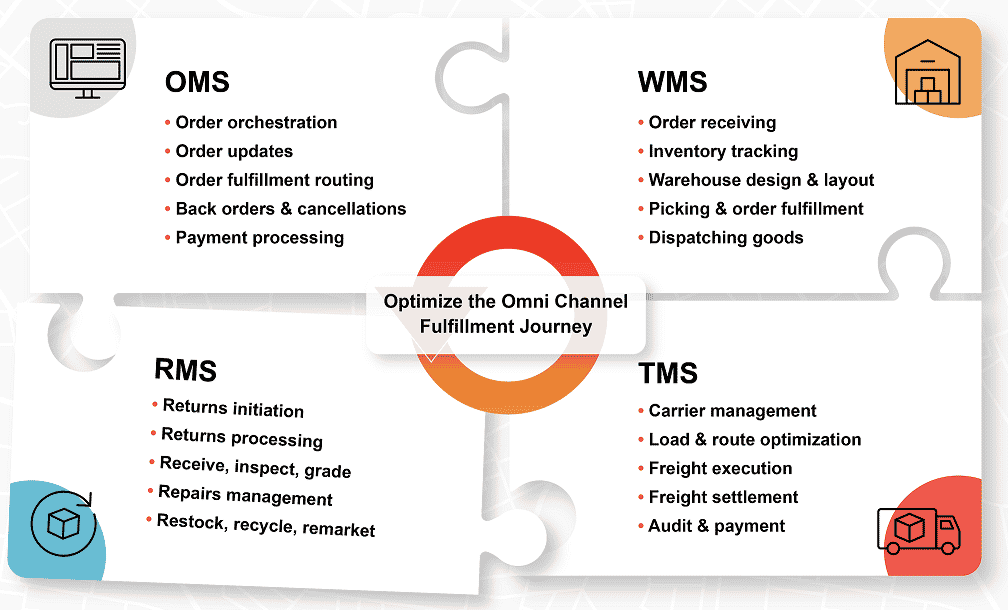8 Tips To Improve Your Returns Management System (RMS)

It’s well-known that product return volumes are increasing across B2C and B2B industries (for example, eCommerce return rates can reach a staggering 30 percent).
Generous returns policies can drive customers’ willingness to return items, which can become a costly and time-consuming part of your operations if the returns aren’t managed efficiently. However, with the right approaches and tools, product returns management can be faster, less costly, and create a frictionless experience for your customers and your employees.
What is Returns Management?
Returns management is a term that covers many facets of a product’s return journey; it’s the supply chain management processes and logistics required to get a product from a customer back to the seller or manufacturer for a refund, credit, exchange or repair.
The “five Rs” of returns management are the foundational components: Returns, recalls, recycling, repackaging and repairs. You learn more about the 5 Rs of returns management here.
How to Improve Your Returns Management System
A return is an opportunity to learn something about your products and customers; it’s the chance to answer the question: “What items were returned and why?”
And yet, few companies know exactly why product returns are happening or the opportunities for process improvement. Let’s look at a few of the most important tips for returns management process improvement.
Understand the Cost of Returns
Knowing your returns management cost is the #1 piece of information that can help you improve returns management. What does it cost you in terms of labor, dollars, and sustainability metrics to process a return? How does that vary by item?
Fewer than one-third of retailers state that they have visibility of all related returns management costs when it comes to loss in inventory value in storage.
– Gartner
In a ReverseLogix research study conducted with Lead to Market, a whopping 80% of respondents said the cost of managing product returns is “significant to severe.” The most common cost drivers reported by respondents were:
- Warehouse space and equipment
- Labor
- Customer service team
- Processing returns into inventory
- Unsellable returns
Some of the common ways to lower the cost of managing product returns include:
- Reducing fraudulent returns
- Automating workflows and processes
- Using the right technology – a returns management system – to manage product returns
Understand Controllable and Uncontrollable Returns
The best product returns are those that never happen. Reduce “controllable returns” with the right strategies that stop returns before they happen.
- Are customers reporting that a product is low quality? Ensure your supplier hasn’t switched materials or processes.
- Are customers reporting sizing issues? Consider virtual dressing rooms or better product descriptions to help customers find the right fit.
- Are all returns legitimate? With standardized returns initiation for distributors, you can track activity and catch fake returns, identify those abusing the returns policy, and reduce overall returns volume.
Uncontrollable returns are, by definition, harder to control and solve for because they aren’t your fault. Perhaps a customer orders three shirt colors in two sizes of each (known as “bracketing”). Maybe a business ordered a component and the business opportunity fell through. For successful and cost-efficient management of uncontrollable returns, consider…
- Shortening the window that a customer can return an item.
- Charge a shipping or restocking fee for returns.
- Educate customers on what happens to their returns (many returns, regardless of industry, end up in a landfill). This may help them reconsider whether to bracket their purchases.
Have a Clear Return Policy
Customers should easily find a returns policy and packing slip on your website, and clearly understand how to make a return. Even if you have a solid return policy, it’s a good practice to review it regularly for needed changes.
- Are return guidelines clear?
- Are fees communicated?
- Are the return steps clearly stated?
- Is contact information listed for customer questions?
- To minimize customer service calls, do you offer an estimated timeline for a refund, credit or exchange?
To make sure you’re on the right track with fair guidelines, get our best practices for creating and implementing a returns policy.
Communicate (and automate!) (h3)
Customer service teams are often asked: “Where is my order?” “Where is my exchange?” and “When am I getting my refund?”
With current supply chain challenges and labor shortages, these timelines are getting longer.
Although timelines may be out of your control, you can turn a return or exchange into an opportunity to strengthen the customer relationship.
- Automate customer communications via email, text or portal to reduce customer service calls.
- Consider a customer chatbot on your website that can give basic information about returns.
- Based on return codes, drive additional sales through personalized offers or content.
- Offer convenient return options, like prepaid shipping labels, return to store, or schedule a carrier pick-up.
Analyze Your Returns
Gathering and analyzing return data is difficult if you are managing returns with several point solutions. A robust returns management technology, such as a returns management system, will aggregate returns data and deliver data in a centralized location.
We’re finally able to see the big picture behind our returns. It’s been a gamechanger to be able to discover specific problems in our workflows and then dig deeper on how to resolve it.
– ReverseLogix Customer
With real-time tracking and insights across the returns journey, you can dive deeper into minimizing controllable returns and managing the returns you receive more efficiently.
- Understand returns by type of product, product manufacturer or product attributes.
- Discover common factors that can help pinpoint the root cause of a high return volume.
- Capture reason codes for better inventory planning.
- Get data on your facility teams’ speed and workflows, so you can improve efficiencies.
Process Returns Fast
From a customer perspective, speed is everything when it comes to an item return. The refund, credit, repair or exchange should happen ASAP. Although some factors like bogged-down supply chains and labor shortages may be unavoidable, automation improvements can significantly increase speed.
Once a customer makes a return through the returns portal, your custom automated rules can streamline decisions.
- Automatically approve straightforward returns based on your parameters.
- Set rules for cleaning or swiping returned items.
- Configure workflows by location, customer and product.
- Set rules and policies for partners that standardize the returns process across a network.
Get Visibility into Returns Tracking and Forward Tracking
It’s important to have complete shipping visibility into an order, and that includes forward tracking of order shipments. Instead of relying on one system for shipping and another for tracking, look for a returns management system that can offer both.
- Keep customers informed with the shipment or return information they need.
- Easily capture and review order, shipment performance information and consumer feedback and communications.
- Feature promotions, coupon offers, and cross-selling opportunities through branded customer portals.
Know the Best Location for Managing Returns
The cost of managing returns by location can shape where you direct customers to make a return. For example, McKinsey found that it’s usually more expensive for apparel companies to manage a returned item received in the mail than one returned to a physical location.
Based on cost, labor resources and efficiency, choose the best location for managing your product returns.
- Fulfillment center or warehouse
- In a store
- Via mail or carrier pick-up
- Via mail to your 3PL; some 3PLs offer reverse logistics services and can fully manage customer returns.
The Benefits of Returns Management Software
Although efficient product return management is increasingly important for B2B and B2C organizations, few have optimized their returns processes.
This is where returns management software can differentiate your organization. Specifically, a returns management system (RMS) coordinates and streamlines every aspect of the returns journey and after-sales care management.
An RMS is a cloud-based, SaaS solution that manages the entire, end-to-end returns process based on an organization’s specific needs. It centralizes and analyzes returns data from other core supply chain software like a WMS, TMS and OMS.

ReverseLogix offers the only end-to-end, purpose-built RMS for B2C, B2B or hybrid organizations. The benefits of ReverseLogix returns management software include:
- Save money and make customers happier. After implementing an RMS, ReverseLogix customers have reported up to a 5% increase in profits and a 15-25% increase in customer satisfaction.
- Save employees time. Employees need standardized, digital workflows to efficiently receive and process returns. An RMS also helps you set rules around managing warranties or repairs.
- Reduce error rates. When returns and purchases are verified with an RMS, error rates drop. For instance, an RMS will record an actual item count. Therefore, a manufacturer will only credit its dealers for actual received inventory, which will be verified in the RMS prior to crediting.
- Gain visibility into returns data and trends. Knowing return reasons will help you catch problems faster. Only an RMS aggregates and analyzes returns data for a single source of returns insight.
